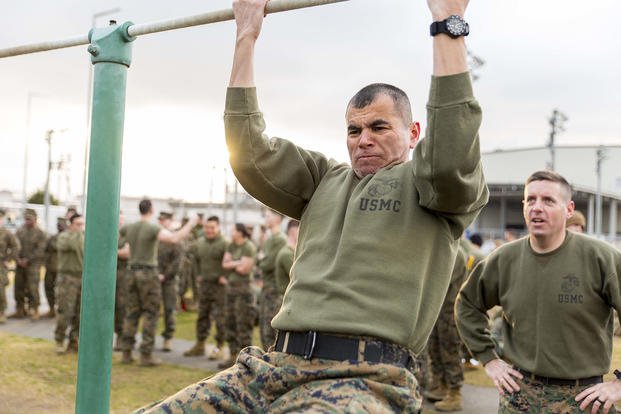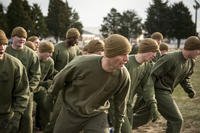There was a large response to the following articles this week about pull-ups. We discussed the practical tactical fitness testing exercise that the pull-up can be, as well as ways to do your first pull-up or maximize your ability to do them.
Pull-ups -- A Tactical Strength Testing Exercise
Pull-ups -- Some Ideas to do More
The following was a common comment after these articles posted:
Stew, I am a 40-year-old man who cannot do pull-ups. I used to be able to do pull-ups over a decade ago, but have lost the ability. Is it my age? Weight? (I could stand to lose 20 lbs.). Or do I just need to get into the gym and practice more pull-ups, or "pulling exercises" as you put it?
After a few emails back and forth, I found this man used to weigh 195 when he last did pull-ups. Now at 220, pull-ups are not happening.
This is why men typically cannot do pull-ups. With just an average weight gain of a few pounds per year, you are 20-25 pounds overweight after 10 years. Even for those who do pull-ups regularly, a 25-pound weight vest makes doing pull-ups significantly harder and easily can drop performance by 50%-75%.
Couple that weight gain with not continuing to try pull-ups in a regular workout routine (three days a week), and you have the perfect storm and reason why these men cannot do pull-ups.
The same holds true for the novice exerciser in their early to mid-teens. If that teen is lean, they likely may have enough natural strength to do a few pull-ups. Put 15-, 20- or 30-plus pounds of fat on that same teen, and a pull-up never is going to happen until that extra weight is lost.
So if you want a performance goal that also will help you with other aesthetic goals of weight loss, try the pull-up as a way to achieve both performance strength and fat loss.
Here is how you do it:
Portion Control
Reduce the amount of food you eat, period.
I am making this simple. You do not have to start a crazy diet plan, eliminate carbs and fats, or eat grapefruits for a month. Just use smaller plates.
It really comes down to how many calories of food you are putting into your body each day. If you have a perfectly clean diet and have a caloric surplus of 500 calories a day, regardless of activity, you will gain weight. Eat a balanced diet of good foods, including carbs.
Try to eliminate sugars and processed foods, but get good carbs and nutrients from fruits and vegetables, and good proteins from all sources from meats, eggs, plants, nuts and supplements, if needed. You need fat, too, but obviously it is limited.
You can make this as difficult as you want with percentages, counting calories and fasting, but if you reduce your current food intake, you will see a difference quickly. See this link for more nutrition guidance.
Hint helper: Drink more water if you are feeling hungry. Most of the time, we are just thirsty and think we are hungry.
Lift, PT and Add Cardio
Building muscle and burning calories are essential to weight loss (fat) and muscle growth, so that you can add a pull-up to your workout routine. Try lifting or doing upper-body calisthenics three times a week, and spread them through the week so you have a recovery day between workout days. You should do some form of cardio and/or leg workouts on the days in between.
I like a three-workout approach to maximizing pull-ups; if you cannot do pull-ups, you can replace the exercise with pulldowns, TRX rows, Australian pull-ups (low-bar pull-ups with feet on the floor), dumbbell or barbell rows, and biceps curls.
These exercises are replacements for pull-ups. However, do not resort to them until you have tried a pull-up, jumping pull-up or negative pull-up -- even if you fail.
Here is one way to train for pull-ups (as well as other exercises that will balance out your workout):
Pyramid Workout (Monday): This is the classic method to building pull-ups, push-ups, sit-ups and any other exercise you like or need to master.
Super Set Workout (Wednesday): This is a sub-max effort foundation workout to increase the volume of your PT exercises.
Max Rep Set Workout (Friday or Saturday): If you cannot do pull-ups, you will have to resort to other pulling exercises to reach these kind of numbers.
As you can see, it takes work. Good luck and enjoy the journey.
Stew Smith is a former Navy SEAL and fitness author certified as a Strength and Conditioning Specialist (CSCS) with the National Strength and Conditioning Association. Visit his Fitness eBook store if you're looking to start a workout program to create a healthy lifestyle. Send your fitness questions to stew@stewsmith.com.
Want to Learn More About Military Life?
Whether you're thinking of joining the military, looking for fitness and basic training tips, or keeping up with military life and benefits, Military.com has you covered. Subscribe to Military.com to have military news, updates and resources delivered directly to your inbox.


















